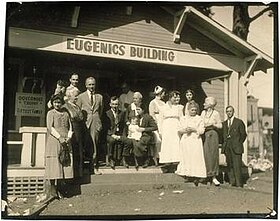
Back تحسين النسل في الولايات المتحدة Arabic Eugenika ve Spojených státech amerických Czech Eugenesia en Estados Unidos Spanish اصلاح نژاد در ایالات متحده آمریکا Persian Eugénisme aux États-Unis French Eugenika di Amerika Serikat ID Eugenetica negli Stati Uniti d'America Italian 美国的优生学 Chinese

| Part of a series on |
| Eugenics in the United States |
|---|
Eugenics, the set of beliefs and practices which aims at improving the genetic quality of the human population,[2][3] played a significant role in the history and culture of the United States from the late 19th century into the mid-20th century.[4] The cause became increasingly promoted by intellectuals of the Progressive Era.[5][6]
While ostensibly about improving genetic quality, it has been argued that eugenics was more about preserving the position of the dominant groups in the population. Scholarly research has determined that people who found themselves targets of the eugenics movement were those who were seen as unfit for society—the poor, the disabled, the mentally ill, and specific communities of color—and a disproportionate number of those who fell victim to eugenicists' sterilization initiatives were women who were identified as African American, Asian American, or Native American.[7][8] As a result, the United States' eugenics movement is now generally associated with racist and nativist elements, as the movement was to some extent a reaction to demographic and population changes, as well as concerns over the economy and social well-being, rather than scientific genetics.[9][8]
- ^ "A social register of fitter families and better babies" The Milwaukee Sentinel . 26 May 1929.
- ^ "Eugenics". Unified Medical Language System (Psychological Index Terms). National Library of Medicine. 26 September 2010.
- ^ "Eugenics; Its Definition, Scope and Aims 1". Nature. 70 (1804): 82. May 1904. Bibcode:1904Natur..70...82.. doi:10.1038/070082a0. S2CID 41155237.
- ^ Susan Currell; Christina Cogdell (2006). Popular Eugenics: National Efficiency and American Mass Culture in the 1930s. Ohio University Press. pp. 2–3. ISBN 978-0-8214-1691-4.
- ^ Leonard, Thomas C. (2005). Eugenics and Economics in the Progressive Era. Journal of Economic Perspectives. Retrieved January 29, 2022.
- ^ Freeden, Michael (February 11, 2009). Eugenics and Progressive Thought: a Study in Ideological Affinity. Cambridge University Press. Retrieved January 29, 2022.
- ^ Newman, Carla (Spring 2018). "Bartering from the Bench: A Tennessee Judge Prevents Reproduction of Social Undesirables; Historic Analysis of Involuntary Sterilization of African American Women". Georgetown Journal of Law & Modern Critical Race Perspectives. 10 – via Gale OneFile: LegalTrac.
- ^ a b Kluchin, Rebecca (2009). Fit to Be Tied: Sterilization and Reproductive Rights in America, 1950–1980. Rutgers University Press. pp. 10, 73, 91, 94, 98–100, 102, 182–183.
- ^ Mukherjee, Siddhartha (2016). The Gene. Scribner. pp. 82–83.
© MMXXIII Rich X Search. We shall prevail. All rights reserved. Rich X Search